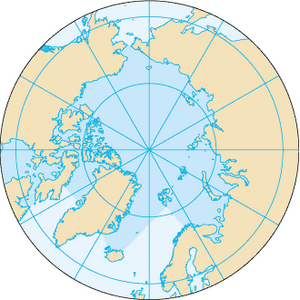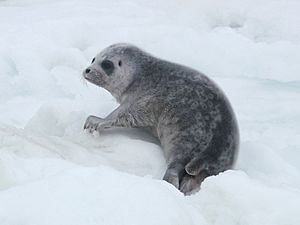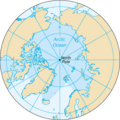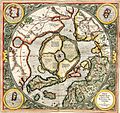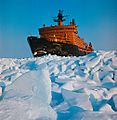North Pole facts for kids
The North Pole is the very top point of our planet, Earth. Imagine a spinning top; the North Pole is where its spinning axis comes out. It's located in the Arctic Ocean, which is a very cold place. It's so cold because the Sun doesn't shine there for about half of the year. Even when the sun is out, it never rises very high in the sky. The ocean around the pole is always freezing, covered by a thick layer of ice.
There's also a North Magnetic Pole. This is the spot a compass needle points to. It's close to the actual North Pole but not exactly the same place.
A special star called the North Star, or Polaris, is always visible right above the North Pole. Sailors and explorers used this star to find their way. They could tell how far north they were by how high the North Star appeared in the sky.
Contents
Day and Night at the North Pole
Imagine a day that lasts for months! At the North Pole, the sun stays above the horizon all summer long. This means it's daylight for about six months straight. Then, during winter, the sun stays below the horizon for about six months. This is called the polar night.
The sun starts to appear just before March 20th, which is the March equinox. It slowly climbs higher in the sky for three months. It reaches its highest point around June 21st, the summer solstice. After that, it starts to sink. The sun finally sets around September 23rd, which is the September equinox.
When the sun is visible, it moves in a flat circle around the horizon. It slowly rises higher each day after March and then sinks lower each day until September. This is why sunrise and sunset at the poles are the slowest on Earth. They take weeks, not minutes!
This amazing pattern of day and night happens because of Earth's axial tilt. Our planet is tilted as it orbits the sun. This tilt stays almost the same all year. In summer, the North Pole leans towards the sun. In winter, it leans away. The South Pole has the opposite experience, with its summer when the North Pole has winter.
Time Zones at the North Pole
Most places on Earth use time zones based on their longitude. This means midday happens when the sun is highest in the sky. But at the North Pole, all lines of longitude meet! Also, the sun only rises and sets once a year. So, it's tricky to decide what time it is.
There are no people living permanently at the North Pole. Because of this, no specific time zone has been set for it. Explorers and scientists visiting the pole often use a time zone that's easy for them. They might use Greenwich Mean Time (GMT) or the time zone of the country they started their journey from.
Climate and Weather at the North Pole
The North Pole is much warmer than the South Pole. This is because the North Pole is at sea level, in the middle of an ocean. The ocean holds a lot of heat, which makes the area a bit milder. The South Pole, however, is on a high landmass, which makes it much colder.
Even though it's covered in ice, the North Pole's climate is a bit like a tundra. In July and August, temperatures can get just above freezing.
In winter, temperatures at the northernmost weather station in Greenland can drop to around -50°C (-58°F). The average winter temperature is about -31°C (-24°F). The North Pole itself can be even colder. However, sometimes strange storms can cause temperatures to rise. For example, on December 30, 2015, the temperature at a buoy near the pole reached 0.7°C (33°F)!
Summer temperatures (June, July, August) usually stay around 0°C (32°F), which is the freezing point. The warmest temperature ever recorded at the North Pole was 13°C (55°F). This is much warmer than the South Pole's record high of only -12.3°C (9.9°F).
The sea ice at the North Pole is usually about 2 to 3 meters (6 to 10 feet) thick. But the ice can change quickly. Its thickness, how far it spreads, and how much open water there is can all vary a lot because of weather and climate changes.
Animals and Plants at the North Pole
Polar bears usually don't go much farther north than 82° North. This is because there isn't much food for them there. However, their tracks have been seen near the North Pole. One expedition in 2006 even saw a polar bear just 1 mile (1.6 km) from the Pole!
The ringed seal has also been spotted right at the Pole. Arctic foxes have been seen less than 60 km (37 miles) away.
Birds like the snow bunting, northern fulmar, and black-legged kittiwake have been seen at or very close to the Pole. Sometimes, birds follow ships, so these sightings might be a bit misleading.
Fish live in the waters at the North Pole, but probably not many. A Russian team explored the seabed at the North Pole in 2007. They didn't see any sea creatures living there at first. However, later reports said they found a sea anemone in the mud. Video from their dive also showed some unidentified shrimps and amphipods.
Who Owns the North Pole?
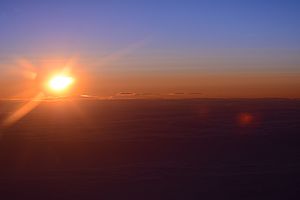
Right now, no country owns the North Pole or the ocean around it. This is based on international law. Five countries are close to the Arctic: Russia, Canada, Norway, Denmark (because of Greenland), and the United States. These countries have a special area called an Exclusive Economic Zone that extends 200 nautical miles (370 km) from their coasts. The area beyond that is managed by the International Seabed Authority.
Countries that have signed the United Nations Convention on the Law of the Sea have 10 years to claim an extended continental shelf. This is an area of seabed that is a natural extension of their land. If a claim is approved, the country gets rights to any resources on or under that part of the seabed. Norway, Russia, Canada, and Denmark have all started projects to make these kinds of claims in the Arctic.
In 1907, Canada claimed a "sector" of the Arctic that stretched from its coast all the way to the North Pole. Canada still holds this claim, but they didn't strongly push for it until 2013.
Related pages
Images for kids
-
An azimuthal projection showing the Arctic Ocean and the North Pole.
-
Temporary research station of German-Swiss expedition on the sea ice at the Geographic North Pole in 1990.
-
Gerardus Mercator's map of the North Pole from 1595.
-
The German North Pole expedition 1990, using a Ski-Doo for research on pack-ice.
See also
 In Spanish: Polo norte para niños
In Spanish: Polo norte para niños


